
Increasing Visibility
A task force presents recommendations for strengthening the leadership pipeline of Asian, Asian American, and Native Hawaiian/Pacific Islander cancer researchers.
When William Pao, MD, PhD, was elected to the Board of Directors of the American Association for Cancer Research® (AACR) in 2022, the number of people with Asian backgrounds in leadership positions was small compared to those in the AACR membership as a whole.
While people living in Asia or of Asian American background constituted 35% of the AACR’s 2023 membership, they made up only about 6% of Fellows of the AACR Academy, 14% of committee members, and less than 20% of journal editorial board members. Dr. Pao, the CEO of Revelio Therapeutics in New York City, is one of just 11 people of Asian descent to serve on the Board of Directors since the AACR’s founding in 1907, and only two Asian Americans have been elected AACR president.

In response to these data, the AACR Asian/Asian American and Native Hawaiian/Pacific Islander (AANHPI) Task Force, composed of 19 AACR leaders in the U.S. and Canada and seven in Asia, was formed, with Dr. Pao chairing the group. The task force evaluated how the AACR could take steps to “strengthen the leadership pipeline of Asian and Asian American and Native Hawaiian/Pacific Islander (AANHPI) cancer scientists and physicians in AACR and, more broadly, in the field of cancer research and care,” according to its mission statement.
The U.S. Office of Management and Budget defines Asians as individuals with origins in any of the original peoples of Central or East Asia, Southeast Asia, or South Asia, including Asian Indian, Chinese, Filipino, Japanese, Korean, and Vietnamese people. A Native Hawaiian is defined as an individual with ancestry in the original peoples of Hawaii. Pacific Islanders are defined as individuals with origins in the peoples of Guam, Samoa or other Pacific Islands, such as Fiji, the Marshall Islands and Tonga. The Asian/AANHPI umbrella includes people with origins in 75 countries.
The Asian/AANHPI Task Force met to develop a list of recommendations that it presented to the AACR Board of Directors during the AACR Annual Meeting in April 2024. One of the task force’s top recommendations is to promote global Asian/AANHPI leadership in the AACR. “There’s an opportunity for more visibility of the contributions of those of Asian backgrounds to the AACR,” Dr. Pao said. A big step toward achieving that goal will occur in April 2025, when Lillian L. Siu, MD, a senior medical oncologist at Princess Margaret Cancer Centre in Toronto, becomes the next AACR president at the AACR Annual Meeting 2025 in Chicago. Dr. Siu will be the organization’s second president of Asian background and the first Asian woman.
Additionally, during AANHPI Heritage Month in May 2024, the AACR used social media posts to highlight the achievements of three renowned Asian/AANHPI researchers, including the late Waun Ki Hong, MD, the AACR’s first Asian president. The task force also wrote a commentary for the AACR journal Cancer Discovery that provides strategies for developing Asian/AANHPI leadership in the AACR with the ultimate goal of fostering a more inclusive and effective cancer research landscape.
There’s an opportunity for more visibility of the contributions of those of Asian backgrounds to the AACR.”
– William Pao, MD, PhD
The task force also encouraged the AACR to expand its presence in Asia. “As AACR becomes more and more global, there is a recognition that not only do we have collaborations in Europe, but we also need to do more in Asia,” Dr. Pao said. The AACR will host additional scientific meetings in Asia, ideally rotating among different countries, according to Dr. Pao. Also, in 2025, the AACR will open an AACR Asia Office in Singapore, and this will facilitate its efforts to interact with scientists and physicians at all career levels in the region.
Finally, the task force hopes the AACR can inspire more Asian/AANHPI scientists to publish in its 10 peer-reviewed journals. Dr. Pao noted that some researchers in Asian nations may hesitate to submit their research if they don’t see anyone with an Asian background listed on a journal’s editorial board, so the task force supports increasing Asian representation on these boards.
Dr. Pao said the information and recommendations have been “eye opening” for many on the AACR Board of Directors. He noted that task force members have appreciated how receptive the organization’s leadership has been to their suggestions and are excited to see them implemented. He especially thanks Margaret Foti, PhD, MD (hc), AACR CEO, for her role in establishing and supporting the task force.
“With the demographics of the organization—35% of the members being of Asian background—it’s showing that the AACR recognizes that and recognizes the contributions of this group,” Dr. Pao said.





